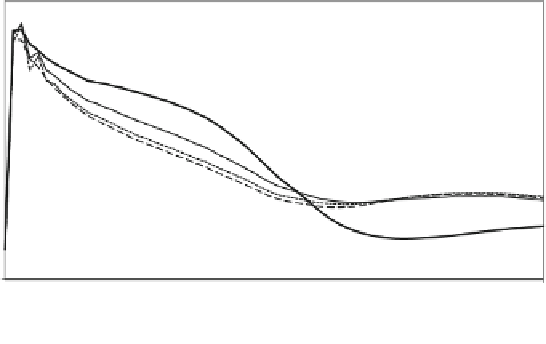Geoscience Reference
In-Depth Information
1.18
1.16
Ageing only
0.6% immigration
1.2% immigration
1.5% immigration
1.14
1.12
1.10
1.08
1.06
1.04
1.02
2005
2010
2015
2020
2025
2030
2035
2040
2045
2050
2055
2060
2065
2070
0.0%
0.6%
1.2%
1.5%
Fig. 11.8
Impacts of immigration on wages
following the Scenario 3 contribute to dropping the dependency ratio in the 2030s
to 19 %, which is the same level (in 2005) before the impacts of an ageing
population. Taking into account the characteristics of immigrants, who are usually
younger and lower-skilled than the resident population, newly admitted immigrants
are assumed to be equally distributed between the ages of 21 and 35, and whose
average productivity is about 60 % of the peak at 47 years of age. The baseline
Scenario, whose results are compared with Scenario 1 through 3, assumes an ageing
population with no immigration. This is the scenario that was introduced in the
previous section.
Figure
11.8
examines the impacts on wages. The inflow of young immigrants,
initially, lowers the capital/labor ratio, which in turn contributes to a decrease in
wages. However, after the initial period, the fall in the capital/labor ratio
corresponding to accumulating immigrants decreases and ceases its downward
trend around 2040, about 5 years earlier than the case of baseline (no ageing or
immigration). After 2040, the wages under favorable immigration remain higher
than the baseline case. This result is somewhat counter intuitive because large
immigration should be expected to exert a strong downward impact on wages. One
possible reason for this result is because the first immigrants start to retire in the
early 2040s, resulting in an increase in the capital/labor ratio. However, there are
two more important factors at work for this result to happen. The first factor is that
the more immigrants that are admitted, the more native workers can save since
immigrants will significantly reduce the social security tax burden (by increasing
the after-tax income of native workers). Further, at the time of immigration, it is
assumed that the capital does not flow into the host country with immigration, but
once immigrants start to work and acquire the higher levels of productivity, they
can accumulate more savings, thereby increasing aggregate capital stock. This
is a critical assumption, especially as it pertains to the second and succeeding
generations of offspring from the original immigrants.






































